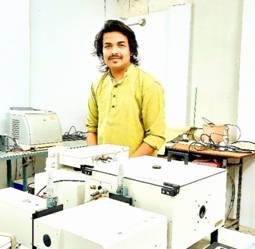Ministry of Science & Technology
INSPIRE Faculty fellow modifying tiny dots for fabricating optical materials useful for optical sensors, light-emitting purposes, energy conversion & composites
Artificial Intelligence (AI) has a beginning, but no end and would evolve with time: Secretary, DST, Prof Ashutosh Sharma
प्रविष्टि तिथि:
01 APR 2021 12:22PM by PIB Delhi
Dr. Satyapriya Bhandari, from the Department of Chemistry, University of North Bengal, West Bengal, is fascinated by tiny nanoscale crystals which, when hit by ultraviolet light, emits light of multiple colours.
This recipient of the INSPIRE Faculty fellowship instituted by the Department of Science & Technology, Govt. of India is using chemical reactions to modify the surface of these nanoscale crystals called quantum dots (QDs) for fabricating optical materials that can have sustainable applications in optical sensors, light-emitting usages, composites and fluorescent biological labels.
Chemically modifying the surface of QDs can be an innovative pathway to alter their optical features and making newer optical materials, which are useful for fabricating white light-emitting (WLE) materials, ratiometric sensors for detecting disease responsive molecules or environmental pollutants, photocatalysts (for H2 production) and imaging of cancerous cells.
Dr Bhandari’s chemically modified QDs could be used for ratiometric tracing of in vitro pH, detection of amino acid and vitamin B12, developing advanced WLE materials that can emit day-bright light, capability to image cancerous cells and packaging of enzymes to enhance their activity.
The research was published in journals Chemical Communications, Advanced Optical Materials, Chemistry: an Asian Journal, and Nanoscale Advances. Dr Bhandari has worked on construction of advanced, sustainable and environment-friendly optoelectronic materials and sensors, setting a new paradigm in the area.
In collaboration with IIT Guwahati, he established a dual emitting nanoprobe which can serve as a sensor for the detection of Hg2+ and Cu2+ ions. The work has been published in the journal ‘Journal of Material Chemistry C’ recently.
With the inspire faculty fellowship, he is working on the fabrication of QD-based optical materials for advanced energy and sensing applications that can be used for household lighting, alternative fuel production, better human health monitoring and for clean and sustainable environment.

Publications links:
1. https://doi.org/10.1039/C9CC01088B
2. https://doi.org/10.1039/D0NA00540A
3. https://doi.org/10.1039/D0TC01788D
4. https://doi.org/10.1002/asia.202000466
For more details, Dr Satyapriya Bhandari (saty.nano[at]gmail[dot]com; satyapriya@nbu.ac.in) can be contacted.
****
SS/KGS/RP (DST Media Cell)
(रिलीज़ आईडी: 1708890)
आगंतुक पटल : 1279